 The Society of Illustrators will host the “Little Nemo: Dream Another Dream” exhibit.
The Society of Illustrators will host the “Little Nemo: Dream Another Dream” exhibit.
This program honors the work of the “Little Nemo in Slumberland” comic strip creator, Winsor McCay. The closing date has been scheduled for March 28th.
According to the organization’s website, this art show is “based on Locust Moon Press’ anthology Little Nemo: Dream Another Dream, many of the world’s finest cartoonists pay tribute to the master and his masterpiece by creating 118 new ‘Little Nemo’ strips, following their own voices down paths lit by McCay. Contributors to the exhibit include Paul Pope, Gregory Benton, Dean Haspiel, Yuko Shimizu, Jim Rugg, Ronald Winberly, Andrea Tsurumi, Raul Gonzalez III, and more!” Click here to see samples from the book.
While we were enjoying Comic Arts Brooklyn this year, my partner Marguerite Van Cook and I took a break from the excitement of promoting our new Fantagraphics Book The Late Child and Other Animals to go across the street to a little coffee bar and have a snack. The young counterperson noted the influx of odd personages hauling portfolios and piles of comics and asked, “is that a convention?”
I replied, “Well, a convention is more like one of those huge things with wrestlers, porn stars and superhero comics, all mixed together with a lot of cosplayers. This is more of a gathering of especially individualistic birds in the alt/lit comics scene. I guess you could call it a ‘murder’ of cartoonists.”
She laughed and asked about the origin of that phrase, which usually describes a flock of crows. But not to further elaborate that conversation, what follows is a review sampling of comics, many of them with poetical aspects, that I got at CAB and other recent releases. Note that I don’t actually try to kill my subjects, but rather to remark on their positive aspects, wherever possible.
____________________________________________________________
Jungle Book by Harvey Kurtzman (Kitchen Sink/Dark Horse, $24.99)
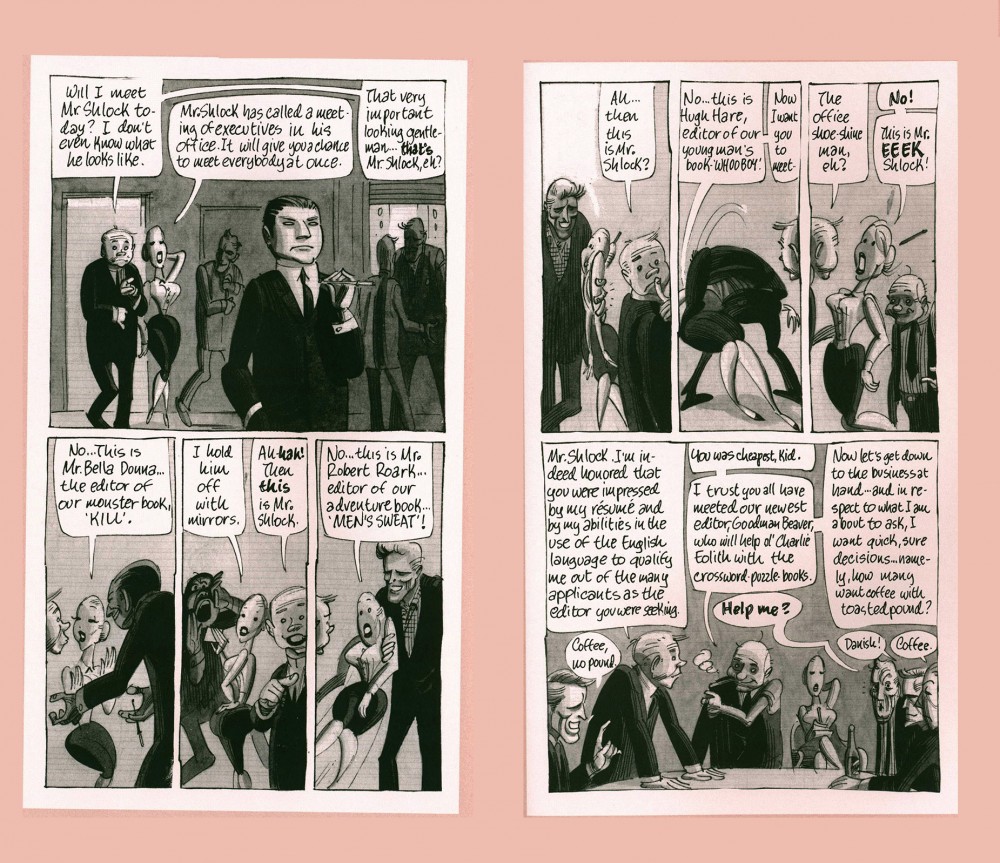
A rare solo effort by the auteuristic creator of E.C.’s two excellent war comics titles Two-Fisted Tales and Frontline Combat, working in the satiric mode he initiated for Mad. Now, I do very much like Kurtzman’s solo work; see Fantagraphics’ recent collection of most of his solo E.C. stories, Corpse on the Imjin (which also contains a smattering of his odd, briefer collaborations, like those with Alex Toth and Joe Kubert). His own drawings have a powerful thrust and direct emotionality that can be lost or greatly altered when filtered through the sensibilities of the artists charged to re-illustrate his layouts. In Jungle Book, which was originally released by Ballantine Books in 1959 as a dingy, downscale paperback, Kurtzman’s targets include a jazz/noir mashup, a TV western and most impressively, in “The Organization Man in the Grey Flannel Executive Suite”, a cutting sendup of the fierce sexism that polluted the offices of his former employer, ex-Marvel Comics owner Martin Goodman. This brilliant strip is nonetheless disparaged as “weak” by famed misogynist and Kurtzman discovery R. Crumb, in the afterthought conversation between the underground artist and Peter Poplaski that cabooses this otherwise beautifully-produced hardcover reprint volume.
____________________________________________________________
Andre the Giant: Life and Legend by Box Brown (First Second, $7.99)
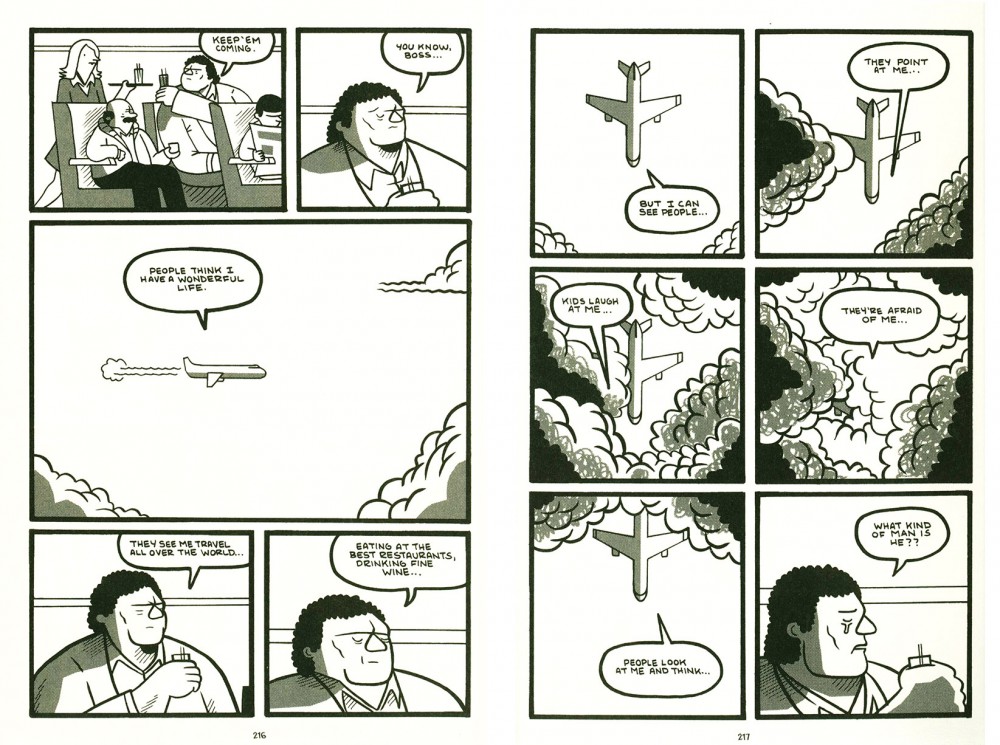
Brown’s biography of wrestling star Andre Roussimoff joins a small group of comics masterpieces that deal with this most theatrical of sports, from Jaime Hernandez’s Whoa Nellie from 2000 to a series of tongue-in-cheek horror collaborations by Mike Mignola and Richard Corben in more recent years, including their 2011 graphic novella House of the Living Dead. Brown’s is a remarkably consistent effort with effective graphic sequences such as the one pictured above and I also admire his restrained handling of the heavily staged fight scenes, as well as his unusual architectural establishing shots. Brown’s stark, spare and precise cartooning create a unique mood, as they contextualize Andre’s success with a tragic acknowledgement of the unrelenting sense of otherness and diminished opportunities for social interaction that he experiences due to his exceedingly unusual scale; as well as his size’s harsh repercussions on his health.
__________________________________________________________
Fear My Dear: A Billy Dogma Experience by Dean Haspiel (Z2 Comics, $19.95)
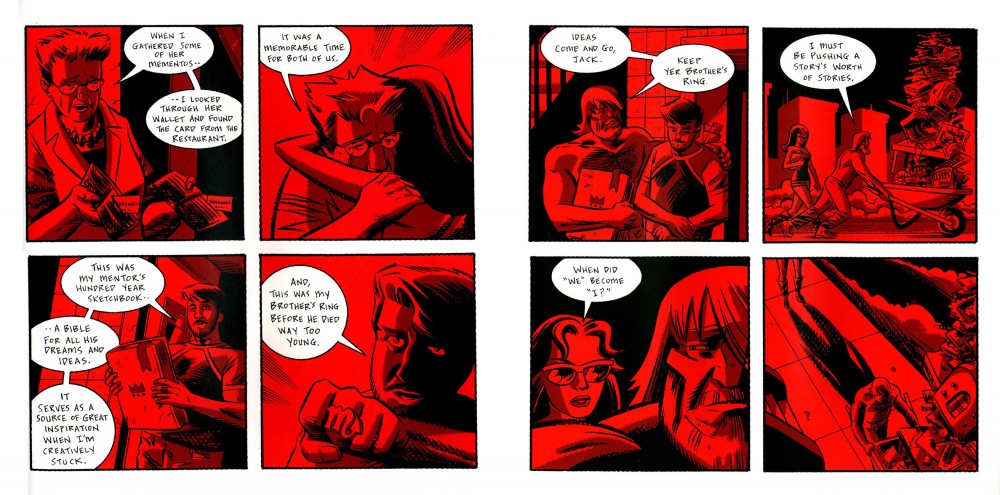
The pair of poetic graphic stories in Fear, My Dear reflect Dino’s unfettered physicality and passionate persona. Since winning an Emmy award for his TV collaboration with Jonathan Ames, Bored to Death and The Alcoholic, their graphic novel from Vertigo, Haspiel has if anything become bolder and more exuberant. For this nicely produced hardcover from Josh Frankel’s new Z squared imprint, the artist uses a four-panels-per-page grid format and a monochromatic color scheme (red in the first piece, yellow and orange in the second, both with an elegant use of white for emphasis) to further define the relationship between his creator-owned characters Billy Dogma and Jane Legit. Their romance haunts post-apocalyptic urban rubble and breaks through to a star-crossed dreamscape, only to end up where they knew they must: together.
____________________________________________________________
How to Pool and Other Comics by Andrea Tsurumi (self-published, not priced)
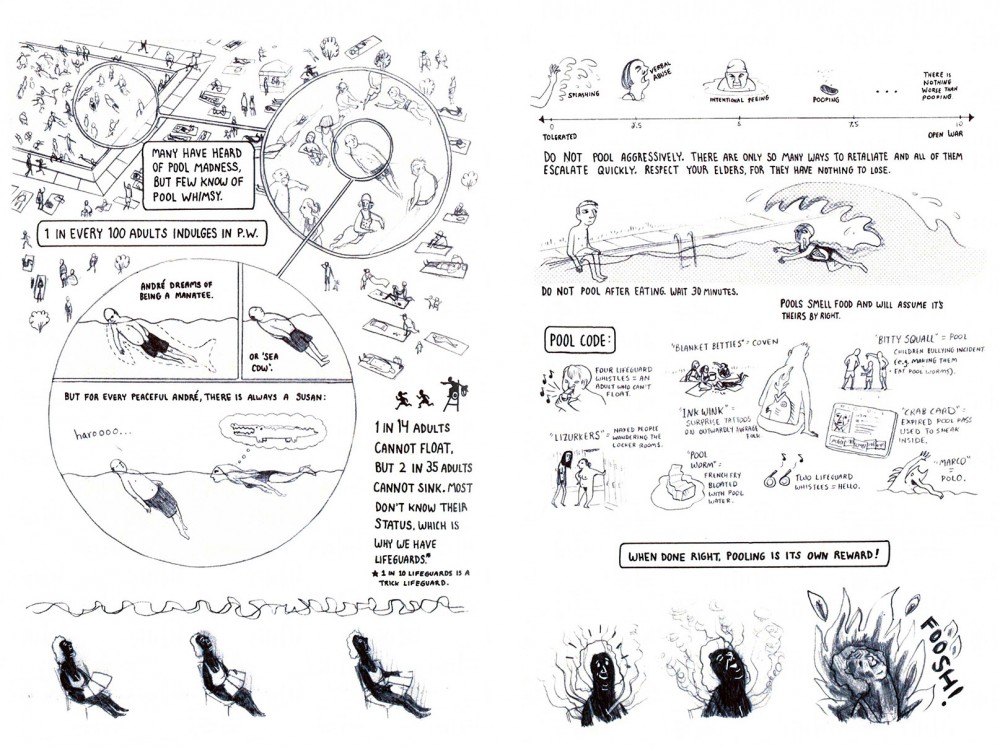
Marguerite and I used to bask our way through the East Village dog days at the Pit Street Pool, and more recently as guests of the Miami Book Fair, we whiled away every spare moment by the steamy roof pool at our hotel. So, I can totally relate to the lead piece in Tsurumi’s new minicomic, wherein the artist collects a variety of witty graphic vignettes about group soakings in fluoridated waters, among other delicately drawn ironies and anthropomorphisms.
____________________________________________________________
Inkbrick #1 by Rothman, Sullivan, Kearney, Tunis, et al (Inkbrick, not priced)

This pocket-sized anthology of comics that incorporate, or are adapted from, poetry is made up of remarkable short stories done in a variety of mediums that range from full color to black & white. Immediate standouts for me are Paul K. Tunis’s watery montages for “Avenge Me, Eavesdropper,” Gary Sullivan’s oblique ink rendering of horrific Asian mythologies, “Black Magic”; Simone Kearney’s whimsically etched “Mobilization”; and editor Alexander Rothman’s “Keeping Time” (pictured above), a piece apparently finished in colored pencils that inventively expresses non-visual sensory impressions such as sound, smell and touch.
____________________________________________________________
The Graveyard Book, Volumes 1 and 2 by Neil Gaiman, P. Craig Russell et al (Harper Collins, $19.99 each)

Although The Graveyard Book continues Neil Gaiman’s anti-collaborative self-hype at the expense of his artist partners, I do appreciate P. Craig Russell’s adaptations of Gaiman’s stories into comics form. Russell’s elegant cartooning and storytelling are paced far better than if Gaiman had scripted; it worked beautifully for Murder Mysteries, Coraline and The Dream Hunters. Now, for Gaiman’s morbidly charming tale of a live boy shielded from a cabal of serial killers by the shades of the deceased occupants of a cemetery and raised by them to young adulthood, Russell acts artistically in a way similar to Kurtzman’s E.C. methodology: he adapts the text and does layouts; the finishing artists serve as illustrators. This makes for a surprisingly smooth and consistent read. I particularly admire the polished renderings of Kevin Nowlan (seen above), Scott Hampton, Jill Thompson and the Russell-miming Galen Showman; and although a somewhat discordant note is sounded by the grotesqueries of Tony Harris, the whole is unified by colorist Lovern Kindzierski and illuminator Rick Parker, who hand-lettered the text, for me a visual treat in these days of page-deadening digital fonts.
____________________________________________________________
Lazarus #1-9 by Greg Rucka, Michael Lark and Santi Arcas (Image Comics, $2.99 each)

I drew one of Greg Rucka’s first comics stories (“Guts” in DC/Vertigo’s Flinch #8, 2000), but it seems to me that the writer doesn’t take as much advantage as he might of the properties that are unique to comics—almost everything he does might work just as well if not better as TV shows. In his 2012 collaboration with Matthew Southworth, Stumptown, it is Southworth’s expressive drawing that provides most of the interest and its most effective use of the medium is that the artist rendered Vol 2, #4 with a Toth-esque sideways, widescreen layout. For Lazarus, a story of a female assassin in a dystopian, nearly medieval America run by a select group of powerful families that is absorbing enough and has had some striking moments, but still often has a feeling of deja vu about it, a lot of the heavy lifting is provided by artist Michael Lark’s cinematic near-photorealism, accomplished in collaboration with Santi Arcas’ hi-tech color graphics.
____________________________________________________________
Thought Bubble #4 by Kot & Sampson, Lim & Rios, Starkings & Sale et al (Image Comics, $3.99)

This color tabloid is a showcase for the participants in the UK’s Leeds Comic Art Festival. My favorite piece is a sort of gentle advisory poem that in its course expresses a goal that many sensitive artists hold dear: that of “making things that help other people feel less alone.” It is the work of the writer of Image’s fascinating rotating-artist series Zero, Ales Kot, expressively drawn with upended, widescreen and oblique imagery by Alison Sampson, who just won a British Comic Award for emerging talent; and nicely colored by Jason Wordie. Also notable: a beautiful page by Hwei Lin and Emma Rios; and an Elephantmen strip written by Richard Starkings and elegantly rendered in ink washes by Tim Sale.
____________________________________________________________
Nightworld #s 1-4 by Adam McGovern, Paolo Leandri & Dominic Regan (Image Comics $3.99 each)

A tale of questing, embattled superhero-ish spirits, Nightworld manages to not only convey an approximation of the look of a Jack Kirby comic book, but it also comes closer than anything else I have seen to capturing something of the spirit of that master’s fierce and restless creativity. Artist Leandri hits a spot somewhere between majoring in Kirby, minoring in Steranko and echoing the early work of Barry Smith, back in the day when he was emulating Jack. Leandri’s spreads can look remarkably as if they were actually drawn by Kirby and his character designs and action passages likewise (see example above), without ever feeling as appropriated, or as forced, as those by some other artists who attempt to adhere as closely to the same model. These comics are colored by Regan with an oddly chosen palette that, again, is reminiscent of Kirby’s psychedelic experiments with Dr. Martin’s dyes. Moreover and significantly, writer McGovern’s poetic voice uniquely grasps a sort of post-traumatized and humane melancholy of narrative, the most tragic scenes of which are appropriately followed and leavened in a Shakespearean mode by bursts of frenetic humor, that can be seen in Kirby’s best writing.
____________________________________________________________
Towards the end of his life, witnessing the rise of the graphic novel as a format, Will Eisner commented on the fact that his books formed a subsection of the graphic novels display at a large bookstore by clarifying that his desire was to see his books shelved in the literature section alongside works by Jewish-American novelists of his generation (as expressed in an interview with David Hajdu). It’s enough to make you chuckle that he wasn’t pleased enough with the impact his books had on pushing the graphic novel format forward in American comics, but at the New York Comic and Picture-Story Symposium on the 11th of March, an Eisner-Week event critiqued the comparison between Eisner and his generation of fellow writers to see if his work stood up to his own claim of similarity. Speakers Jeremy Dauber (Professor in Yiddish Studies at Columbia University) and Danny Fingeroth (educator, author, former Marvel Comics editor and Chair of the Organizing Committee for Will Eisner Week) investigated Eisner’s use of setting, dialogue, and themes, as well as common cultural references he shared with his generation, to place Eisner in context and challenge the divide typically assumed between prose and comics media.
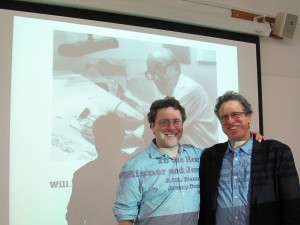
[Dauber and Fingeroth]
Dauber pointed out, in opening, that Will Eisner’s work is not usually considered in comparison to novels. He’s known for his prose, and often narrative-heavy work, but close textual comparisons between his writing style and those of his contemporary prose-writers is sparse, or even non-existent. Born in 1917, and “coming of age” in the 20’s and 30’s, Eisner, Dauber said, “was present a the foundational moment of Modern American Jewish Literature” and surrounded by the same influences and trends of major novelists of the period. Abraham Cahan, for instance, who fled from Czarist Russia to become a longtime editor of Yiddish newspapers in New York, was a “break through writer” in establishing Jewish-American literature. He often described the “urban landscape” as “something that’s alive”, as artist Andrea Tsurumi observed during audience participation. In comparison, Eisner’s CONTRACT WITH GOD gives a strong sense of place, and often speaks in a “high register” of prose, like Cahan’s work.
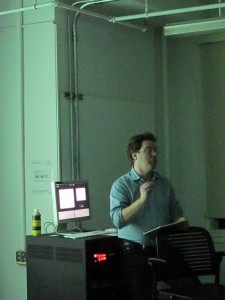
[Jeremy Dauber]
Another prose writer who became a “household name” during Eisner’s childhood was Anzia Yezierska, the “Cinderella of the tenements”, who often found herself in conflict with her parent’s generation, forged her high school diploma in order to attend college, and found herself exploring the conflict between the old and new world in her prose. Her use of dialogue, contrasting idiomatic Yiddish-English with her own more formal style of English speaks to a tension also visible in Eisner’s dialogue. Dauber presented novelist Henry Roth’s work as a final comparison in the use of dialogue to show differences in cultural background also found in Eisner’s Dropsie Avenue inhabitants. Dauber also pointed out a similar fascination with religious experience as a “transforming” force between Roth and Eisner.
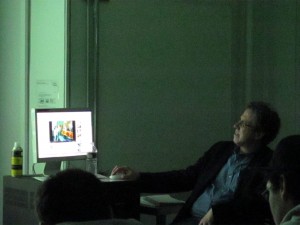
[Danny Fingeroth]
While Dauber explored prose comparisons between Eisner’s work and other Jewish-American novelists, Fingeroth took a more visual approach to putting Eisner in context. He addressed the fact that many of the novels of Eisner’s generation and milieu found their way into film adaptation, like Philip Roth’s GOODBYE COLUMBUS (1969). This forms a visual link to Eisner’s own graphic novels and work as an artist. Like Saul Bellow, Eisner also embraced a strong sense of comedy in his work, whereas authors like Bellow didn’t seem to acknowledge comics as an expression of their generation. In a video clip Fingeroth played for the audience, Eisner described himself as “growing up in an environment of prejudice and exploration of identity”, a theme certainly visible in many of the Jewish-American novels of the period. Eisner’s injected his characteristic humor by adding that writing was “inexpensive long term therapy” for these issues.
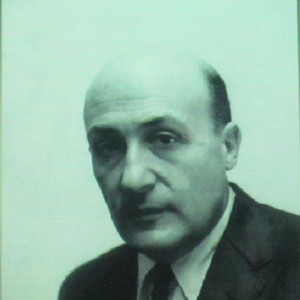
[Will Eisner]
Fingeroth described the “Jewish-American assimilation experience” as a common feature of Eisner’s work and his novelist contemporaries. CONTRACT WITH GOD, the “first thing” Eisner created in his long career that “wasn’t an actual assignment” allowed him the freedom to revisit these very personal experiences. Fingeroth also noted that a common cultural reference among these writers was Baseball, as seen in Philip Roth’s THE GREAT AMERICAN NOVEL, and in Eisner’s artwork on “The Adventures of Rube Rooky”. Writing about baseball, Fingeroth explained, was a “leveling process” between cultures that became part of the assimilation process. Visually speaking, Fingeroth said, Eisner was a “master of this craft of depicting urban life” found in celebrated Jewish-American novels. Particularly in A CONTRACT WITH GOD, Eisner, “given the freedom to do what he wanted to…came up with stories based on the Bronx of his youth”, like other writers of his generation.
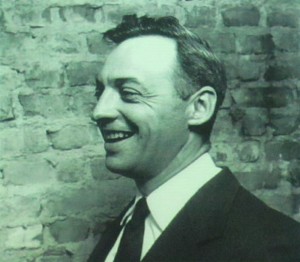
[Saul Bellow]
Fingeroth reminded the audience that exploring Eisner’s prose shouldn’t take away from Eisner’s own assertion that he “wrote with pictures”, though. According to Dauber and Fingeroth’s research, Eisner wrote “as well as anyone” else prominent in his generation. To understand Eisner’s legacy, we have to keep in mind that he “thought of himself as someone who wouldn’t be complete without pictures”, Fingeroth said. So, after this careful textual and cultural comparison between Eisner and the Jewish-American novelists of his day, what was the verdict? Could Eisner’s works be placed in the “literature” section of a bookstore next to the novels he felt expressed the same messages? “Will made it”, Fingeroth confirmed, “He belongs there, too”.

During the question and answer period, discussion turned toward Eisner’s overwhelming drive to raise awareness of comics as a medium. Fingeroth described Eisner as being on a “mission to explain his own life and to legitimize comics”. It’s a puzzling thing that Eisner apparently wanted graphic novels to be seen as “mainstream” literature rather than as a separate format, but the answer may lie in his sense that graphic novels were still being segregated from literature and therefore not treated as equal creative achievements. The double presentation of Eisner’s work in context from Dauber and Fingeroth made a strong argument for Eisner’s status alongside novelists of his day, especially in terms of subject matter and prose style. Dauber and Fingeroth presented reasonable evidence that Eisner’s work could be reshelved in the literature section at any bookstore, but it might cause quite a tug of war with those who see his work of “legitimizing” comics as most at home in a separate graphic novels section of books. “Ideally, all sorts of books could be shelved in more than one section of a bookstore or library,” Fingeroth added in a follow-up comment, “but a variety of practical reasons make that unlikely for the time being. Online venues seem to be able to do it, though, so hopefully some version of that will come to brick-and-mortar outlets, too.” So, why not place Eisner’s books in both locations? It might remind readers, for one thing, to view Eisner as a cultural peer of many of the novelists he revered.
Hannah Means-Shannon writes and blogs about comics for TRIP CITY and Sequart.org and is currently working on books about Neil Gaiman and Alan Moore for Sequart. She is @hannahmenzies on Twitter and hannahmenziesblog on WordPress.
 The Society of Illustrators will host the “Little Nemo: Dream Another Dream” exhibit.
The Society of Illustrators will host the “Little Nemo: Dream Another Dream” exhibit.



















Nightworld looks great and I will pick it up especially with Romberger’s recommendation. I also advise anyone to get Rombergers The Late Child as his art is sublime
Thanks, James. I’m honored.